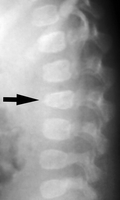Fractures in any infant or toddler are concerning, but not all fractures are equally associated with non-accidental trauma (NAT). A 2008 systemic review from BMJ reviewed over 30 studies concerned with all manner of fractures in children under 18 years of age. The following was noted:
Fractures resulting from abuse were more common in infants (<12 months) and toddler’s (age 1-3 years). As expected, multiple fractures were more common in NAT. Skull fractures were not however. Other fractures with increased likelihood of being associated with abuse include:
Rib fractures
The compressive force applied while an infant is held and shook can result in fractures to the ribs – often posteriorly. These injuries may not be seen initially, but will show up as multiple healing callouses as seen in this image.
Bucket handle/Corner fractures
These crescent-shaped osseous densities paralleling the metaphysis are characteristic of child abuse and are often seen at the distal femur. They can occur when a child is firmly grabbed and twisted/shook. The flailing limbs suffer damage near the epiphysis.
Mid shaft humerus fracture
Clearly a significant amount of force is needed to break an arm – and a transverse fracture of the midshaft humerus should always raise concern for abuse. Supracondylar humeral fractures are less likely to be associated with NAT however.
Vertebral compression fractures
Again, a fracture to the axial skeleton requires tremendous force. vertebral fractures are no different.
















